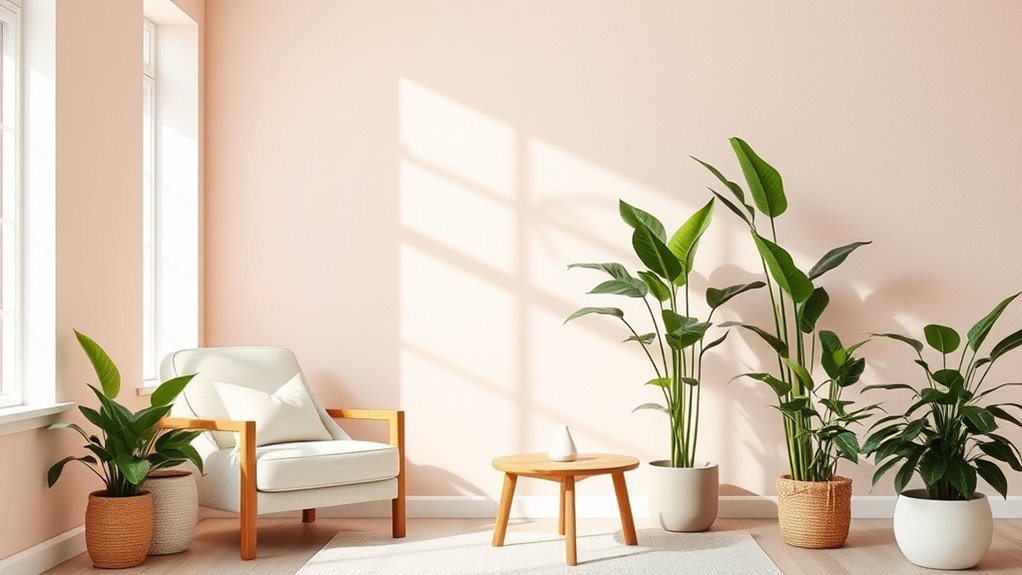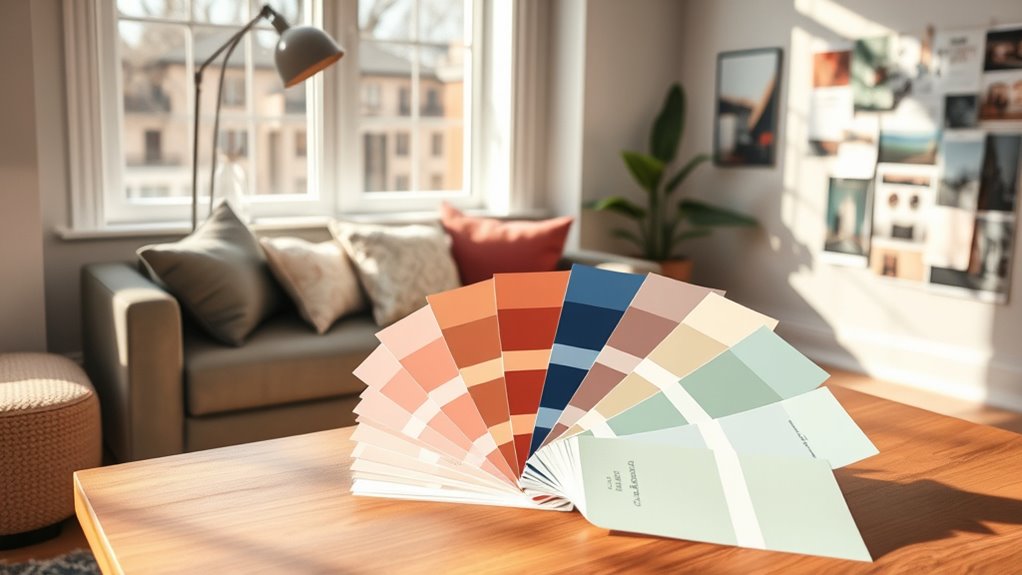To choose the right paint color for your home, start by evaluating your space and lighting—natural light and room size influence how colors appear. Reflect on your personal style and the mood you want to create, whether calming or energizing. Explore current trends and gather inspiration from art or nature. Test selected colors in your environment to see how they look at different times of day. Keep these tips in mind, and you’ll be ready to make confident choices that truly suit your space.
Key Takeaways
- Assess natural and artificial lighting to determine which colors will appear best in your space.
- Consider room function and desired mood to select appropriate hues, such as calming tones for bedrooms.
- Test paint samples in different lighting conditions before committing to ensure color harmony.
- Draw inspiration from nature, art, or current trends to choose colors that reflect your personal style.
- Coordinate colors and finishes to create cohesive, inviting, and functional spaces throughout your home.
Assess Your Space and Lighting Conditions

Before choosing a paint color, you need to evaluate your space and lighting conditions carefully. Natural light, artificial lighting, and the size of the room all influence how colors appear. Bright rooms with plenty of sunlight can handle darker shades or bold hues, while smaller, dimly lit spaces may benefit from lighter, reflective colors. Consider color psychology—calming blues for bedrooms or energizing yellows for kitchens—to set the right mood. Additionally, explore different paint finish options like matte, satin, or semi-gloss, as finishes can affect how light interacts with the color and the room’s overall ambiance. Taking these factors into account guarantees your chosen color enhances the space and creates the desired atmosphere. Lighting conditions play a crucial role in how paint colors look once applied, and understanding how artificial lighting impacts color perception can help you make more informed choices. Understanding color rendering can further assist in selecting hues that appear consistent in different lighting environments. Being aware of the environmental factors, such as nearby windows and outdoor views, can also influence your decision. Additionally, considering the contrast ratio between wall colors and furniture can further refine your selection to achieve visual harmony.
Determine Your Personal Style and Mood Preferences

Think about colors that inspire you and reflect your personal style, whether it’s modern, traditional, or eclectic. Consider how different shades make you feel—calm, energized, or cozy—and choose those that set the right mood. Matching your preferred colors with your style helps create a space that truly feels like you. Incorporating seasonal color palettes can also enhance the overall ambiance, aligning your choices with current trends and seasonal influences. Exploring holistic care models can inspire you to select colors that promote well-being and balance in your home environment. Additionally, understanding color psychology can help you choose hues that support your emotional health and comfort, especially knowing that decluttering your space can lead to a more organized environment that fosters positive feelings. Practicing stillness while designing your space can also bring clarity to your choices, ensuring they truly resonate with your inner preferences.
Explore Color Inspirations
Have you ever considered how your personal style and mood influence your ideal paint colors? Exploring color inspirations begins with understanding color psychology and cultural symbolism. Color psychology reveals how different hues can evoke specific feelings—calmness with blues or energy with reds—helping you select shades that match your desired atmosphere. Cultural symbolism adds another layer, as colors may carry meaningful associations unique to your background or preferences. For example, white often symbolizes purity in one culture but mourning in another. By reflecting on these aspects, you can identify colors that resonate deeply with your personality and values. Gathering inspiration from art, nature, or interior design magazines can further clarify your style, guiding you toward a palette that feels authentic and inspiring.
Identify Mood Preferences
Determining your personal style and mood preferences is an essential step in choosing the right paint colors. Understanding color psychology helps you select hues that evoke specific emotional impacts, whether you want calmness, energy, or coziness. Consider how different colors influence your mood: blues often promote relaxation, while reds can energize a space. Reflect on your daily routines and the atmosphere you want to create in each room. Your personal style—modern, traditional, eclectic—also guides color choices that align with your aesthetic. By identifying these preferences, you guarantee your home’s colors support your emotional well-being and reflect your unique personality. This clarity will make the next steps in color selection more intuitive and satisfying. Additionally, dog names can be a fun way to personalize your space and reflect your personality through subtle decorative choices. Recognizing how color psychology influences perception can further refine your choices to create harmonious living environments, fostering comfort and positivity in your home. Incorporating psychological color effects into your decision-making process ensures your space not only looks appealing but also enhances your overall mood and well-being. Understanding color associations can help you select shades that complement your desired ambiance and promote a balanced atmosphere throughout your home.
Match Personal Style
Once you’ve identified the moods and feelings you want your space to evoke, aligning those preferences with your personal style helps create a cohesive look. Your personal style reflects your artistic expression, so choose colors that resonate with your aesthetic, whether it’s modern, rustic, or eclectic. Consider how color symbolism influences your choices—soft blues might evoke calm, while bold reds energize a room. By matching your style with your mood preferences, you ensure your space feels authentic and inviting. This harmony between colors and personal expression makes your home not only visually appealing but also emotionally supportive. Incorporating color psychology insights can further enhance your decision-making process, ensuring your choices align with the desired emotional impact. Understanding emotional resonance can help you select hues that truly foster a welcoming atmosphere. Additionally, considering the WWE Raw’s Financial Impact on entertainment industries can inspire you to choose vibrant and engaging colors that energize your living space. Being mindful of personal color preferences can also help you select hues that truly reflect your individuality and make your space uniquely yours. Exploring cultural associations with different colors can deepen your understanding of how your choices might influence the overall atmosphere.
Explore Color Trends and Inspirations

Looking at current color trends can spark new ideas for your space. You might find inspiration in popular palettes that are making waves this season. Don’t forget to observe nature’s endless color combinations—they often influence the most beautiful and timeless choices. Incorporating color harmonies inspired by natural patterns can help create a cohesive and harmonious home environment. Additionally, considering regional color preferences can ensure your choices resonate well with your local aesthetic. Being aware of security vulnerabilities in design choices can also prevent costly mistakes down the line.
Trending Color Palettes
Staying updated with trending color palettes can transform your space, infusing it with fresh energy and modern style. To choose the right palette, consider how color psychology influences mood and energy. Trending colors often reflect current cultural shifts and design preferences. Here are some ideas to keep in mind:
- Opt for muted tones like soft greens and warm beiges for a calming atmosphere.
- Incorporate bold shades such as deep blues or vibrant yellows for lively accents.
- Use color coordination to balance contrasting hues and create harmony.
- Follow current trends, but personalize with colors that resonate with your style and personality.
Staying on top of these palettes helps you craft a space that feels fresh, cohesive, and true to your vision.
Inspiration From Nature
Nature provides a limitless source of inspiration for choosing paint colors, helping you create spaces that feel organic, calming, and authentic. Look closely at flora patterns and natural textures to find color combinations that resonate with the outdoors. Soft greens, earthy browns, and muted blues mimic the hues found in leaves, bark, and sky. Incorporate these colors to evoke serenity and connection to nature. Pay attention to textures like rough bark or smooth stones, which can inspire accent walls or decorative finishes that add depth. By drawing from these natural elements, you can develop a color palette that feels both fresh and timeless, ensuring your home reflects the beauty and tranquility of the natural world.
Test Colors in Your Environment

Before committing to a paint color, it is vital to see how it actually looks in your space. Sample testing helps you observe how the color interacts with your lighting, furniture, and decor. You can do this by:
- Applying small patches of paint on different walls to evaluate color in various lighting conditions.
- Moving samples around the room to see how they look at different times of day.
- Using virtual visualization apps to preview how colors will appear in your environment.
- Comparing multiple shades side-by-side to identify subtle differences.
These steps guarantee you choose a color that complements your space. Testing in your environment prevents surprises and helps you make an informed decision.
Consider the Function of Each Room

Understanding the primary function of each room is essential when choosing a paint color, as it influences the mood and atmosphere you want to create. For example, a calming hue in a bedroom promotes relaxation, while a lively color in a playroom energizes the space. Consider the wall textures, as they can affect how paint finishes look; smooth walls may highlight glossy finishes, while textured surfaces suit matte or eggshell finishes better. In high-traffic areas like kitchens and hallways, durable paints with appropriate finishes are key. In contrast, softer finishes might suit bedrooms or lounges, where comfort is priority. Tailoring your color choices to each room’s purpose guarantees your space feels inviting, functional, and visually cohesive.
Make a Confident Decision and Prepare for Application

Once you’ve chosen the perfect paint color, it’s important to make a confident decision and prepare thoroughly for application. Confidence building comes from careful preparation and knowing you’ve done your homework. To set yourself up for success, consider these preparation strategies:
- Clear the room and protect surfaces with painter’s tape and drop cloths.
- Gather all necessary tools—brushes, rollers, and a roller tray.
- Stir the paint thoroughly and check for consistency.
- Test a small area to ensure color accuracy and finish.
Frequently Asked Questions
How Do I Choose Paint Finishes for Different Rooms?
When choosing paint finishes for different rooms, think about wall texture and paint durability. For high-traffic areas like kitchens and hallways, opt for semi-gloss or satin finishes because they’re durable and easy to clean. In bedrooms or living rooms with smooth walls, matte or eggshell finishes add a soft, elegant look. Consider how the texture of your walls impacts the finish choice, ensuring your paint holds up and looks great over time.
Can I Mix Multiple Colors in a Single Room Effectively?
You can definitely mix multiple colors in a room effectively by using color blending techniques and accent walls. Start with a neutral base to keep the space balanced, then add a bold accent wall or complementary shades to create visual interest. Use cohesive color schemes and guarantee the hues work well together. This approach adds depth and personality without overwhelming the room, making your space feel dynamic and inviting.
How Do I Match Paint Colors With Existing Furniture and Decor?
It’s no coincidence that good color matching effortlessly enhances your space. To match paint colors with your existing furniture and decor, start by identifying the dominant hues. Use color matching techniques like holding paint swatches next to your furniture or taking photos to a paint store. Coordinate by choosing complementary or analogous shades, ensuring your wall color and furniture work harmoniously. This simple approach transforms your room into a cohesive, inviting space.
What Are the Best Practices for Painting With Children or Pets?
When painting with children or pets, prioritize safety by choosing child safe paints and pet friendly finishes. Keep the area well-ventilated, and use low-VOC or zero-VOC options to reduce fumes. Cover furniture and floors with drop cloths, and keep children and pets away during and immediately after painting. Always wash hands and toys afterward, ensuring a safe environment for everyone while enjoying your refreshed space.
How Often Should I Repaint My Home to Keep Colors Fresh?
You should repaint your home based on maintenance schedules and seasonal repainting needs. Typically, interior walls need a refresh every 5-7 years, while high-traffic or humid areas may require more frequent updates. For exteriors, consider repainting every 3-7 years, especially before harsh weather seasons. Regular inspections help you spot fading, chipping, or discoloration early, ensuring your colors stay vibrant and your home remains protected.
Conclusion
Choosing the right paint color is like planting a seed that will grow into your home’s personality. Trust your instincts and let your space be the soil that nurtures your style. With each thoughtful choice, you’re painting the foundation of comfort and beauty. Remember, the colors you select are the symbols of your life’s story—vibrant, calm, or bold. Embrace your vision, and watch your home flourish into a true reflection of you.










